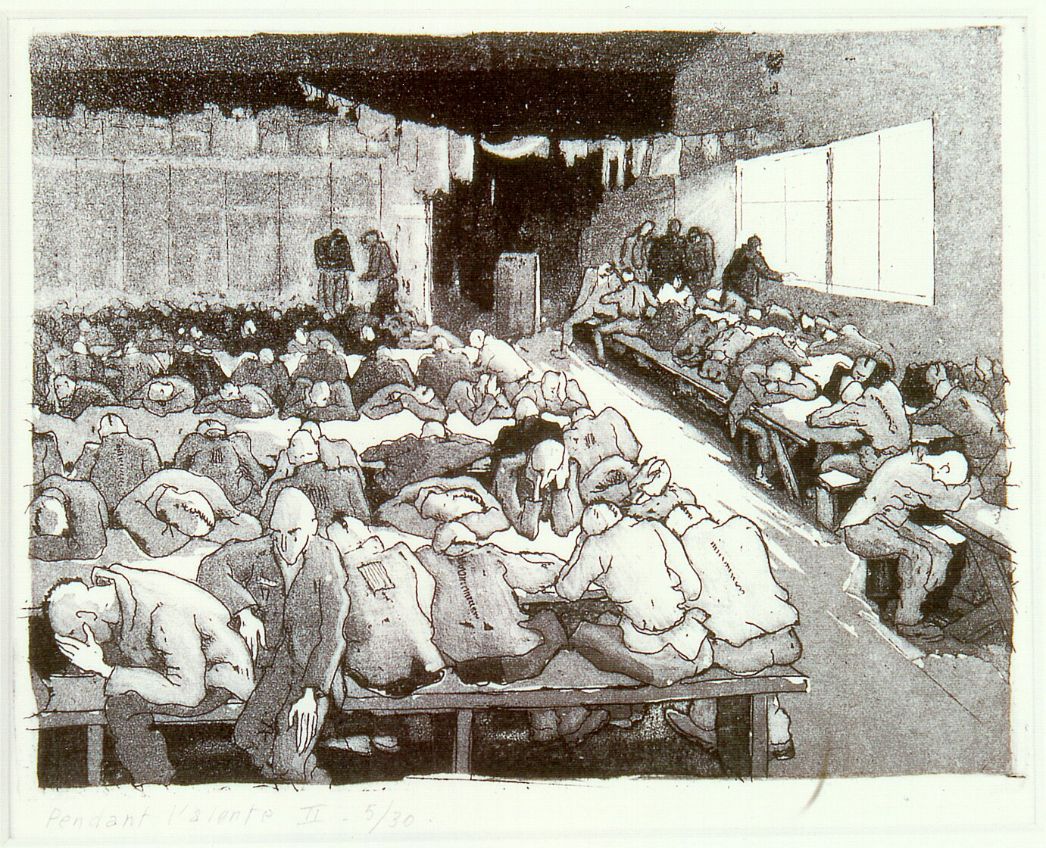
In the etching During the Air Raid Siren II we see people cowering over the dining tables of an inmates’ barrack in a state of exhaustion and despair. Their places at the long tables have been assigned them by the table elders who are also responsible for distributing the hunger rations. Every object has its purpose and its meaning. The scene depicts the phase of an air raid when the Allied bomber formation approaches and flies overhead—an everyday concentration camp occurrence in the weeks before the liberation. “The air-raid alarms are more and more frequent and last longer and longer, two hours and more. When the alarm sounds during work, we stop working and are led to the barrack as quickly as possible. There we wait for the signal telling us it’s over.” (Dr. Georg Roos: Buchenwald, Éditions Médicis, 1945).
Forty years would pass before the survivor José Fosty described the situation in his visual account. The image seen here is one of a series of 24 aquatint etchings about the Buchenwald concentration camp carried out by Fosty in 1985 as a tribute to his artist friend Paul Goyard. After Goyard’s death in 1980, Fosty became the guardian of the 250 pencil sketches Goyard had made in Buchenwald in 1944/45, and based the etchings of his narrative series Les Dimanches à Buchenwald (Sundays in Buchenwald) on them. To print the etchings, he used a press which Goyard had managed to obtain in the post-war period for joint artistic projects, but which had never been used because Fosty had moved away from Paris. After Goyard’s death, it came to Fosty and waited in the studio shed in his garden in Visé —for operation, for the design of the narrative cycle dedicated to Fosty’s companion, artistic mentor, and friend Goyard from their time in the camp—for the late memories of Buchenwald.
Biography
José Fosty was born in the small town of Dalhem in Liège Province in the Wallonian region of Belgium on 31 August 1919. He developed an interest in drawing at an early age and received his first instruction at the art academy in Saint-Luc near Liège. In 1939 he was conscripted for military service. In May 1940, after the German invasion of Belgium, he was wounded. He received treatment in a hospital in Brussels, where he exhibited his artistic work for the first time. Even before he had fully recovered, he participated in the group “Service de Renseignements et Actions de la Résistance” in Brussels, which carried out acts of resistance against the German occupation.
Arrested by the Gestapo on 11 October 1942, he was initially in the prison of Saint-Gilles near Brussels for two months before being transferred first to Aachen at the end of the same year, and then to the Buchenwald concentration camp on 19 March 1943. There he met the stage designer Paul Goyard, who would have a profound influence on his personal and artistic development. Along with a fellow student from his Brussels days who had likewise been committed to Buchenwald, Fosty assisted Paul Goyard in creating decorations for musical and literary inmates’ gatherings on Sunday afternoons. The young Fosty’s artistic views continued to mature in the passionate discussions with intellectuals of all persuasions and cultural backgrounds, French and Belgians alike, in the camp. After the liberation, he was able to take more than 100 sketches—the output of his Sunday explorations of the place of terror—with him. Art had become a means of survival.
No sooner had he returned from the camp than Fosty participated in creating the designs of decorations for a film about the German concentration camps. He and Goyard lived and worked together in Paris until he moved back to Visé in 1949. There he became a father and managed to feed his growing family—he had two daughters—for more than a decade with the production of wooden toys. When the sale of his products stagnated, he went to work for the post office, sorting letters by night so that he could paint by day. Yet it was only after his retirement as a postal worker that he was able to realize his long-cherished dream of introducing the public to the oeuvre his “père spirituel” Goyard had produced in the camp. José Fosty died in Oupeye on 25 May 2015 at the age of ninety-five.
*In his address at the opening of the permanent art exhibition of the Buchenwald Memorial, 1998


